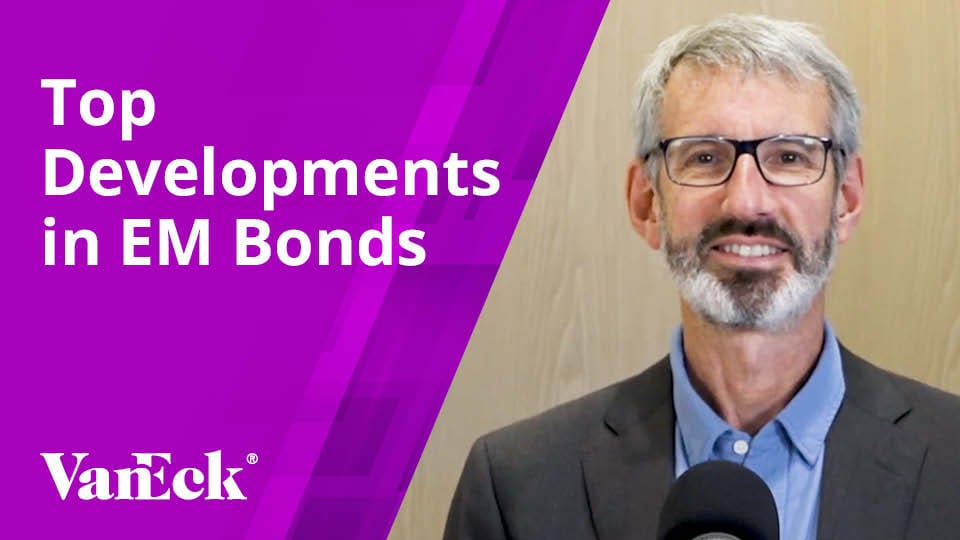Golden Age for EM Bonds
02 May 2024
Read Time 7 MIN
Share with a Friend
All fields required where indicated (*)The VanEck Emerging Markets Bond UCITS (Class USD I1) returned 0.8% in March compared to a return of 1.03% for the 50/50 J.P.Morgan Government Bond Index-Emerging Markets Global Diversified (GBI-EM) local currency and the J.P.Morgan Emerging Markets Bond Index (EMBI) hard-currency index.
| Average Annual Total Returns* (%) as of 31 March 2024 | |||||||
| 1 MO | 3 MO | 1 YR | 3 YR† | Life† | |||
| USD R1 Inc (Inception 12/06/14) | 0.76 | -0.08 | 7.01 | 0.50 | 0.30 | ||
| USD I1 Inc (Inception 20/08/13) | 0.80 | 0.04 | 7.54 | 1.08 | 2.31 | ||
| USD I2 Inc (Inception 20/08/13) | 0.81 | 0.07 | 7.65 | 1.19 | 2.43 | ||
| EUR Hedged I1 Inc (Inception 06/10/15) | 0.66 | -0.36 | 5.37 | -0.96 | 1.62 | ||
| EUR Hedged I2 Inc (Inception 22/08/17) | 0.68 | -0.31 | 5.49 | -0.81 | 0.25 | ||
| 50% GBI-EM/50% EMBI - USD1 | 1.03 | -0.05 | 8.10 | -1.45 | 1.79 | ||
† Periods greater than one year are annualized.
1 Life performance for the 50% GBI-EM/50% EMBI - USD benchmark is presented in U.S. Dollars (USD) as of Class I1 inception date of 20/8/2013.
Developed markets (DM) government bonds (JP Morgan’s GBI Global) were down -3.18% YTD, totally consistent with our view that emerging markets (EM) bonds should outperform DM bonds. Ecuador in USD (our overweight there) was the big winner in March, with Chile local (our overweight there) the loser. During March, the fund made several country-specific changes. We took profit on our remaining China USD exposure and on Nigeria in USD; we also reduced Mexico and Brazil in local currency. We increased exposure to Saudi, UAE, Qatar and Romania in USD with low duration; and we increased exposure to local Malaysia, Singapore and Taiwan Region after their selloffs. Duration ended the month lower. We end March with carry of 6.2%, YTW of 7.95%, duration of 6.4 and 46.7% of the fund in local currency. Our biggest exposures are Brazil (local and hard), Poland (local and hard), Colombia (local and hard), Mexico (hard) and Indonesia (local and hard).
Commodities up/bonds down, with precious metals sending the strongest signal within commodities – this is good for commodity prices but bad for yields, which means opportunities in EM bonds.Sharply rising precious metals prices are always the end result of debt debasement, though there are many frameworks that also link prices to inflation or non-fiscal metrics. Following the global financial crisis (GFC), we wrote a piece in which we divided global central bank money/liabilities by their gold reserves/assets (in order to measure strains on individual central banks and the global money system). The spirit of the question was “what would happen if the U.S. dollar loses its reserve status and is replaced by gold?” What we found was that many EM central banks have a high ratio of gold reserves to money liabilities, indicating that they were more resilient in a scenario in which the U.S. dollar’s reserve status was declining.
EM Bonds have strong fiscal and monetary stances compared to DM bonds.Central banks aren’t just accumulating gold, they are buying EM local currency bonds (especially Asian bonds) as reserve assets, too. This is a slower process, but so was central bank gold accumulation until this year. Do you want to predict the day it gains traction, or get access to an asset class that has a buyer base with big balance sheets and a secular path? When Saudi receives Chinese renminbi (CNY) for oil, what do you think it will do with the CNY? (Answer: buy CNY bonds.) This point was central to our “fiscal dominance” piece. And in that piece, we honed in on EM central bank gold holdings, which have been rising for over a decade. The DM central banks have only just begun to get in on the act, if at all. This, at least, means more careful consideration about whether you’re getting paid enough premium to reward that risk in DM.
Fed Funicular falters – will a stop at a higher terminal rate need to be built? We don’t know. But, we can find bonds in EM that “don’t care”. We’ve used the funicular framing in previous pieces and find it helpful. If the Bayesian facts are that the next decision “node” occurs when the inflation/employment data might be worse, that’s key, game-theoretically. If the right date for that node is July, where do you think the world will be then and do you have confidence in that view, what with wars, locusts and golems about? If you don’t, EM bonds have many ways to insulate you from the range of scenarios, of saying “these EM bonds do best across the scenarios”. So, you get your carry and the price either goes up or down based on U.S. rates. What it shows is what it always shows – EM bonds do best across the rate scenarios. The carry in EM bonds is so high it allows you to not base your fixed income investing on your opinion on the U.S. Federal Reserve (Fed). Sounds good to us.
Exposure Types and Significant Changes
The changes to our top positions are summarized below. Our largest positions in March were Brazil, Poland, Colombia, Indonesia and Mexico:
- We increased our hard currency sovereign exposure in Saudi Arabia, the United Arab Emirates, Qatar, Romania and Poland. Romania’s political noise is set to increase in the run up to the elections, but at the same time a smart issuance policy and the EU funds’ inflows should continue to shelter sovereign bonds, improving the economic and policy test scores for the country. Poland’s sovereign bonds might be less sensitive to political games around the central bank governor’s removal. In terms of our investment process, this boosts the country’s technical test score. As regards the remaining countries, a combination of attractive valuations and solid fundamentals is compelling, and there are also better technical factors as the rest of the region often lacks longer bonds.
- We also increased our local currency exposure in Malaysia, Singapore and Taiwan Region. Malaysia is a fundamentally solid and less correlated to EM credit, which gave a boost to our duration exposure. In terms of our investment process, this reflected the improved technical test score. Singapore’s music tourism appears to be a new growth driver, against the backdrop of lower than expected inflation and a very small fiscal deficit in 2024. All these factors improve the economic test score for the country. Taiwan Region’s local exposure was a nice way to get FX yield pickup.
- Finally, we increased our hard currency sovereign exposure in Benin, Paraguay, Barbados and Cameroon. All these sovereign bonds have attractive valuations (hence, the solid technical test scores). Benin and Cameroon also show the renewed reform momentum, which improved their respective policy test scores.
- We reduced our local currency exposure in Mexico and Brazil. The Mexican peso’s net long positioning is getting stretched, and there are legitimate concerns about preelection spending and the central bank’s initiating its cutting before the Fed’s, which worsen the country’s policy test score. Brazil’s price action was affected by elevated positioning as well as some idiosyncratic risks, such as Petrobras’s dividends story and the government’s fiscal performance, which worsen the policy and technical test scores for the country.
- We also reduced our hard currency corporate and quasisovereign exposure in China. The economy appears to be bottoming out, reducing incentives to increase policy support. We are also disappointed by a lack of clarity about the resolution of real estate developers’ debt, which is a major headwind to the sector and GDP growth in general, worsening the policy test score for the country.
- Finally, we reduced our hard currency sovereign exposure in Mozambique, Mongolia and Nigeria. We took profits in Nigeria after sovereign bonds’ post-election rally. Sovereign valuations in Mongolia and Mozambique and getting stretched, worsening the technical test scores for both countries.
Major Risks of Investing in the VanEck Emerging Markets Bond Fund
- Emerging Market Risk: In emerging markets, the legal, judicial and regulatory infrastructure is still developing and there is much legal uncertainty both for local market participants and their counterparties. Investments in these countries may involve specific political, economic and financial risks that have a significant impact on valuations and liquidity of those investments. They are also exposed to additional risks that are difficult to calculate and would not arise with investments made in OECD countries or other emerging markets.
- Currency Risk: Some of the Fund’s assets can be invested in currencies, other than the Fund’s currency. The performance of the Sub-Fund can be subject to elevated volatility on the downside as well as on the upside due to currency fluctuations. Northbound investments by the Fundin the Bond Connect Securities will be traded and settled in Renminbi / RMB, the official currency of China. The RMB is currently not a freely convertible currency.
- Credit Risk: The Fund will invest in bonds that are subject to varying degrees of risk that the issuers of the securities will have their credit ratings downgraded or will default, potentially reducing the value of the securities.
To receive more Emerging Markets Bonds insights, sign up to our newsletter..
IMPORTANT INFORMATION
This is a marketing communication. Please refer to the prospectus of the UCITS and to the KID before making any final investment decisions.
This information originates from VanEck (Europe) GmbH, which has been appointed as distributor of VanEck products in Europe by the Management Company VanEck Asset Management B.V., incorporated under Dutch law and registered with the Dutch Authority for the Financial Markets (AFM). VanEck (Europe) GmbH with registered address at Kreuznacher Str. 30, 60486 Frankfurt, Germany, is a financial services provider regulated by the Federal Financial Supervisory Authority in Germany (BaFin).
For investors in Switzerland: VanEck Switzerland AG, with registered office in Genferstrasse 21, 8002 Zurich, Switzerland, has been appointed as distributor of VanEck´s products in Switzerland by the Management Company. A copy of the latest prospectus, the Articles, the Key Information Document, the annual report and semi-annual report can be found on our website www.vaneck. com or can be obtained free of charge from the representative in Switzerland: First Independent Fund Services Ltd, Feldeggstrasse 12, 8008 Zurich, Switzerland. Swiss paying agent: Helvetische Bank AG, Seefeldstrasse 215, CH-8008 Zürich.
For investors in the UK: VanEck Securities UK Limited (FRN: 1002854) is an Appointed Representative of Sturgeon Ventures LLP (FRN: 452811), who is authorised and regulated by the Financial Conduct Authority (FCA) in the UK, to distribute VanEck´s products to FCA regulated firms such as Independent Financial Advisors (IFAs) and Wealth Managers. Retail clients should not rely on any of the information provided and should seek assistance from an IFA for all investment guidance and advice.
The information is intended only to provide general and preliminary information to investors and shall not be construed as investment, legal or tax advice. VanEck (Europe) GmbH, VanEck Switzerland AG, VanEck Securities UK Limited and their associated and affiliated companies (together “VanEck”) assume no liability with regards to any investment, divestment or retention decision taken by the investor on the basis of this information. The views and opinions expressed are those of the author(s) but not necessarily those of VanEck. Opinions are current as of the publication date and are subject to change with market conditions. Certain statements contained herein may constitute projections, forecasts and other forward-looking statements, which do not reflect actual results. Information provided by third party sources is believed to be reliable and have not been independently verified for accuracy or completeness and cannot be guaranteed. Brokerage or transaction fees may apply.
VanEck Asset Management B.V., the management company of VanEck Emerging Markets Bond UCITS (the “Fund”), a sub-fund of VanEck ICAV, is a UCITS management company incorporated under Dutch law and registered with the Dutch Authority for the Financial Markets (AFM). VanEck Asset Management B.V. transferred the investment management for the Fund to Van Eck Associates Corporation, an investment company regulated by the U.S. Securities and Exchange Commission (SEC). The Fund is registered with the Central Bank of Ireland and actively managed. Investing in the ETF should be interpreted as acquiring shares of the ETF and not the underlying assets.
Investors must read the sales prospectus and key investor information before investing in a fund. These are available in English and the KIIDs/KIDs in certain other languages as applicable and can be obtained free of charge at www.vaneck.com, from the Management Company or from the following local information agents:
UK - Facilities Agent: Computershare Investor Services PLC
Austria - Facility Agent: Erste Bank der oesterreichischen Sparkassen AG
Germany - Facility Agent: VanEck (Europe) GmbH
Sweden - Paying Agent: Skandinaviska Enskilda Banken AB (publ)
France - Facility Agent: VanEck (Europe) GmbH
Luxembourg - Facility Agent: VanEck (Europe) GmbH
Performance quoted represents past performance. Current performance may be lower or higher than average annual returns shown. Discrete performance shows 12 month performance to the most recent Quarter end for each of the last 10 years where available. E.g. ‘1st year’ shows the most recent of these 12-month periods and ‘2nd year’ shows the previous 12 month period and so on. Performance data for the Irish funds is displayed on a Net Asset Value basis, in Base Currency terms, with net income reinvested, net of fees. Returns may increase or decrease as a result of currency fluctuations.
All performance information is based on historical data and does not predict future returns. Investing is subject to risk, including the possible loss of principal.
No part of this material may be reproduced in any form, or referred to in any other publication, without express written permission of VanEck.
© VanEck
Important Disclosure
This is a marketing communication. Please refer to the prospectus of the UCITS and to the KID before making any final investment decisions.
This information originates from VanEck (Europe) GmbH, which has been appointed as distributor of VanEck products in Europe by the Management Company VanEck Asset Management B.V., incorporated under Dutch law and registered with the Dutch Authority for the Financial Markets (AFM). VanEck (Europe) GmbH with registered address at Kreuznacher Str. 30, 60486 Frankfurt, Germany, is a financial services provider regulated by the Federal Financial Supervisory Authority in Germany (BaFin).
The information is intended only to provide general and preliminary information to investors and shall not be construed as investment, legal or tax advice VanEck (Europe) GmbH, VanEck Switzerland AG, VanEck Securities UK Limited and their associated and affiliated companies (together “VanEck”) assume no liability with regards to any investment, divestment or retention decision taken by the investor on the basis of this information. The views and opinions expressed are those of the author(s) but not necessarily those of VanEck. Opinions are current as of the publication date and are subject to change with market conditions. Certain statements contained herein may constitute projections, forecasts and other forward-looking statements, which do not reflect actual results. Information provided by third party sources is believed to be reliable and have not been independently verified for accuracy or completeness and cannot be guaranteed. Brokerage or transaction fees may apply.
All performance information is based on historical data and does not predict future returns. Investing is subject to risk, including the possible loss of principal.
No part of this material may be reproduced in any form, or referred to in any other publication, without express written permission of VanEck.
© VanEck (Europe) GmbH / VanEck Asset Management B.V.
Sign-up for our ETF newsletter
Related Insights
Related Insights
16 April 2024
15 April 2024
04 March 2024
12 February 2024
01 February 2024





